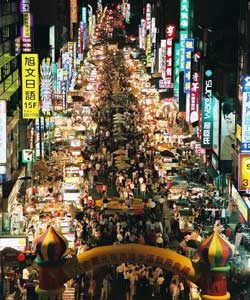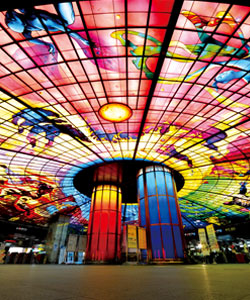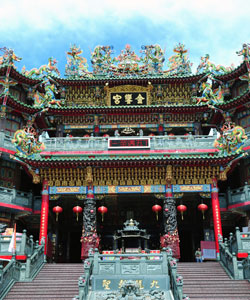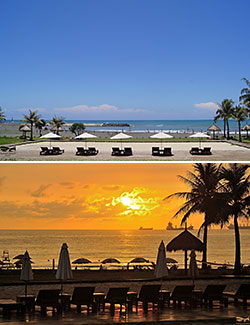          |
|
|
Rated by CNN as one of the most attractive destinations in Taiwan, Kaohsiung has grown from a once industrial harbor into a hub of art and culture.This Taiwan's second largest city is full of mishmash of old and new. In Kaohsiung, you can experience the biggest night market in Southeast Asia, the best seafood, the prettiest metro station, the biggest temple, as well as the coolest arts in Taiwan. No matter you are looking for exciting cultural adventure or a quiet night out, Kaohsiung has something special for everyone.
 The Biggest Night Market
The Biggest Night MarketKaisyuan or Jin-Zuan? Which one is the biggest? It's been the hottest debate in Kaohsiung. The rivalry between Kaisyuan and Jin-Zuan -- two adjacent night markets -- began from the week they opened, only three days apart. Both claim to be the biggest market in Southeast Asia. Each has hundreds of night market stalls. Both are gigantic -- walking through either takes at least an hour. Kaisyuan boasts a 30,000-square-meter space with 300 stalls. Fresh Gourmet Food Gangshan District's lamb hotpot, Moon World's free-range chicken and Shin-Da Harbor and Cijin Island's seafood -- these are just the beginning of a long list of local Kaohsiung foods. Locals love Meinong for authentic Hakka cuisine, such as sticky rice with pork wrapped in leaves and Hakka noodles called Ban tiao. Taro and pork dumplings, aboriginal sausage and rice wine are aboriginal dishes which are graded must-tries when visiting various tribes. And if you have sweet tooth, a Duchuantou's big bowl of shaved Ice, with seasonal mixed fruit and strawberry syrup is the best place to go.  The Prettiest Metro Station
The Prettiest Metro StationThe Formosa Boulevard Station in Kaohsiung is the most beautiful metro station in Taiwan, if not the world. The three-story station was designed by Japanese architect Takamatsu Shin. The above-ground glass entrance is designed to resemble a pair of hands clasped in prayer. But the real treasure is underground -- the 2,180-square-meter Dome of Light, a glass mural built into the ceiling of the station. The colorful ceiling was created by American-Italian artist Narcissus Quagliata. It's the largest such glass installation in the world. Quagliata also built the Dome of Light for Rome's Basilica of St. Mary of the Angels and the Martyrs.  The Biggest Temples
The Biggest TemplesKaohsiung's temples may not be the oldest but definitely are the biggest in Taiwan. Fo Guang Shan, literally "Buddha's Light Mountain, founded in 1967 by Master Sinyun, it is the largest Buddhist temple complex in Taiwan. Fo Guang Shan is famous for its 36 metre high (132 ft) statue of Amitabha Buddha. It has over 200 branch temples all over the world. Zuoying Confucius Temple, which was constructed in 1976, is the biggest Confucius temple in Taiwan. The elegant structure with sections such as Dacheng Hall, Chongsheng Shrine, Minglun Hall and Shuyuan (Academy) accompanied by the willows along the lotus pond, arch bridges and garden paths, present a profound scholarly ambiance. Religious Park Where Visitors Exit From a Tiger's Mouth - Lotus Pond and Dragon Tiger Tower Enter the dragon's mouth for good fortune, exit from the tiger's mouth to banish bad luck. After the dozens temples you may have visited in Asia, you may not be excited about another Buddhist/Taoist destination. But Lotus Pond is a real attraction. Officially opened in 1951 (some temples in the park are more than two centuries old), the Lotus Pond consists a man-made lake with more than a dozens temples, pavilions and pagodas. The Dragon and Tiger Pagodas are two seven-story pagodas guarded by crouching tiger and dragon statues. Visitors enter through the dragon's mouth into a tunnel (inside the dragon's body) with walls embellished with carvings. Visitors exit via the mouth of the tiger for good luck. Old Fongshan City Wall In addition to the efforts built by the Dutch, the old city Zuoying is the first Chinese style city in Taiwan. Built from lao-gu stone, it was also the first city built of stone in Taiwan. The current remaining ruins include: the East Gate, the South Gate, the North Gate, about 500 meters of city wall, the moat, the Jhengfu Shrine and Gongchen Well outside the North Gate. The site has been designated a National Historic Monument. Moon World One can see such mysterious landscape on the side of the road. The unique geology rises up from the surface of the earth and looks like the crest line of the sawtooth with special veins on the surface. Salt crystals glisten under the sun. The barren badland is geologically known as the mudstone, which is badly washed out. It is originally the sedimentary clay on the seabed and comes out of the earth surface after orogenesis. Since the unique landscape resembles the surface of the moon, the spot is named the Moon World. Jhongdou Wetlands Park Covering an area of 12.6 hectares, a winner of the 2012 prestigious FIABCI Prix d'Excellence Award in the Environmental (Rehabilitation/ Conservation) Category, the Kaohsiung Jhongdou Wetlands Park has consolidated local tourism resources and built a complete rainforest restoration and river-shore ecological operation system that is perfect for the rest of migratory birds. It has become an eminent landscape to highlight the position of Taiwan as a tropical paradise.  Cijin Beach
Cijin BeachFrom the Cijin Ferry Station, go straight to the end off Miaocian Road. Cijin Beach has soft sand and blue waters. There is a park right next to the Beach. Lifeguards and lifesaving facilities are available, making it the best choice for swimming and fun in the water during the hot summer months. Beach facilities include a seaside walkway, a nature trail and an ecological zone. Even when the beach is not officially open, many people still enjoy visiting the area. It provides excellent views of ships out at sea as well as the massive Cihou Mountain. Pier 2 Art Center It was once an abandoned and forgotten warehouse buried in history due to the move from an industrial based segment to the service sector. However, with a group of persistent artist who injected waves of creativity and inspiration into the area, the Pier-2 area was released and re-born making the region a place where tourist and locals can come together to enjoy fine art. With the collision of an old area and new fine art, Pier-2 becomes an area of new vitality and liveliness. Located at the sides of the pier are the artistic warehouse clusters. Not only are there unlimited flows of cars, boats, sea breeze and people coming and going every day but also when looking at the vast ocean and sky, one is relaxed, stress-free with limitless thoughts. |